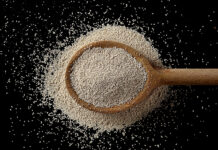[ ADI’s gin insider answers in print the questions queried to him during his talk and gin tasting at ADI’s 10th Anniversary Spirits Conference, in Denver, for the benefit of those not present. ]
There are two main factors to consider when it comes to making gin: One, The Base Spirit; and two, the Botanicals.
The Base Spirit
There are two main choices here: one is to buy in Neutral Grain Spirit from a third party; the other is to distill your own spirit from scratch.
Of the 200+ brands of gin produced in the UK, only about a dozen make their own spirit. In the USA, however, it is much more common to make your own. There are arguments for both: if you make your own base, you have control over the whole process, whereas, if you use neutral spirit, you can focus your attention on the botanical make-up; painting on a blank canvas, if you will.
Producing your own base spirits adds another layer of complexity and another variable with which to give gin character. When distilling from scratch, it makes sense to use the same base for your gin whenever appropriate.
Grain (of almost all varieties) is still the most common base, although grape and potato are growing in popularity. There are already some gins available based on fruit, honey and even root vegetables. The base spirit is also a good way to let the character of your distillery’s surroundings shine through by using local products.
The Botanicals
The herbs, spices, peels and barks that are distilled or infused to give flavor to the base spirit are your botanicals. The most important botanical is juniper and, although in the EU this is restricted to the Juniperus Communis (Common Juniper) variety, in the USA you can use a range of local varieties of juniper berries, each with their own character. Examples include: the large Juniperus Occidentalis (Western Juniper), Juniperus Scopulorum (Rocky Mountain Juniper) and Juniperus Osteosperma (Utah Juniper), which is not only found in Utah, but throughout the south-west of the United States. If you have a local variety available, this is worth investigating.
When it comes to other botanicals — herbs, spices, peels and bark — typically, less is more; if you have good quality botanicals, heaps of them are not required. The quality of botanicals is more important than the number used. Seven
or eight botanicals is generally considered the “sweet spot”, but each botanical should add something meaningful to
the gin’s character.
The six most common botanicals are: juniper (essential), coriander, angelica root (adds dryness), citrus peel, orris root (which helps to bind flavours together) and cardamom. In order to give a special character to your gin, investigate incorporating locally grown species as signature botanicals. This helps to demonstrate the terroir of your gin and differentiate it from those made elsewhere.
When it comes to using fruit, especially citrus, some consideration should be given to the choice between using dried citrus peel and using fresh, whole fruits. The former gives a more refined, subtle character, whereas using whole fruits makes for a more luscious and lively spirit.
As with many things, gin takes time to create and different flavors come off of the still at different times in your run, even when making generous heads and tails cuts. It is best to let the spirit rest in sealed containers (stainless steel) for between two and three weeks after distillation. This allows the flavors to marry, and helps maintain the consistency of your spirit.
A final tip would be to have a clear idea of the character that you want your gin to have: is it going to be classic, but use locally-sourced, organic ingredients? Is it going to be floral, citrus, spicy or savoury? Is it going to represent the flavors of your state or local region? Deciding this early on will give you direction and focus, and help you to make a gin that stands out from the myriad of other spirits out there.








